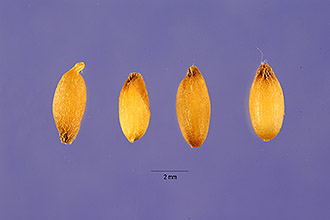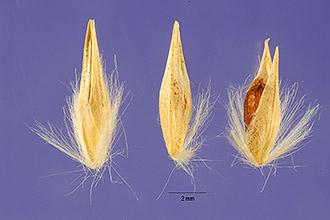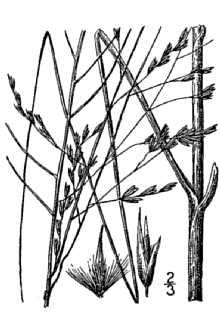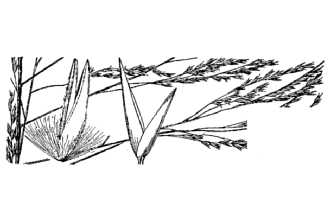Giant Sandreed
Scientific Name: Calamovilfa gigantea (Nutt.) Scribn. & Merr.

| General Information | |
|---|---|
| Usda Symbol | CAGI3 |
| Group | Monocot |
| Life Cycle | Perennial |
| Growth Habits | Graminoid |
| Native Locations | CAGI3 |
Plant Guide
Alternate Names
Big sandreed, big sandreed grass
Uses
Giant sandreed is valuable for controlling erosion on deep sands subject to severe wind erosion. It cures well on the stem, thus providing good winter forage for livestock. When grown on sites large enough to be managed as a separate unit it can be hayed or used as reserve for winter forage.
Status
Please consult the PLANTS Web site and your State Department of Natural Resources for this plant’s current status (e.g. threatened or endangered species, state noxious status, and wetland indicator values).
Description
General: Giant sandreed is a robust perennial, native, warm season grass with strong creeping rhizomes. The culms are erect, thick and solid or hollow near the base. Culm height ranges between 1 and 2 meters tall. The leaf blade is 7 to 11 mm wide at the base and rolls inward tapering to a long tip. The leaf sheath is usually glabrous or sometimes pubescent in the vicinity of the ligule. The inflorescence is an open panicle 30 to 65 cm long with lemmas that are villous on their backs. Distribution: For current distribution, please consult the Plant Profile page for this species on the PLANTS Web site. Giant sandreed can be found from southern Utah (north of Kanab, Kane County) to Arizona, east to southwestern Nebraska, Kansas, Oklahoma, and to central Texas. Habitat: A valuable sand binder that is closely related to Calamovilfa longifolia of the mid-western states. A valuable species to control erosion on deep sandy soils subjected to severe wind erosion. Will grow in large colonies and dominate a site if properly managed.
Adaptation
This species exhibits optimal performance on sandy textured soils.
Establishment
Normally this species exhibits weak seedling vigor and slow growth once it has germinated. This species is typically slow to establish from the seedling stage to a mature plant. It tends to put the majority of its resources into root and rhizome development during the seedling stage. Drill seed 2.54 cm deep in sandy soil and shallower in medium textured soils. Drilling into crop stubble improves stand establishment on erosive sites. Species may be sprigged in sand dunes or erosive “blowout” sites.
Management
Spring growth of this species begins several days before other warm season grasses in the same locality. This provides an advantage when early forage is desired for livestock species. When grown on large sites that require separate management this species can be hayed or grazed. It provides good winter forage for livestock. Summer grazing should be limited to no more than 50 percent removal of the current year’s growth. This will maintain a vigorous stand of grass, while leaving adequate amounts of mulch for control of wind erosion.
Pests and Potential Problems
There are rust fungi that infect or cause disease on both Calamovilfa and Sporobolus.
Environmental Concerns
Concerns , Use soil moisture sensors to measure the soil moisture of Giant Sandreed.
Concerns
There are no environmental concerns with this species. Generally, it has reduced seedling vigor and is only adapted to conditions in a sandy soil type environment. It has a very low probability of becoming a weed problem.
Seeds and Plant Production
Plant Production
Plant Production
The species is difficult to harvest due to late maturity, seed shatter, and hairy seed units. Combine in dough stage, process with hammer mill and fanning mill for best results. Seed quality at best has a purity of 98% and germination of 70% for a Pure Live Seed percentage of 69. Cultivars, Improved, and Selected Materials (and area of origin) Contact your local Natural Resources
Conservation
Service (formerly Soil Conservation Service) office for more information. Look in the phone book for”United States Government”. The Natural Resources Conservation Service will be listed under the subheading “Department of Agriculture.” There are currently no cultivars or improved varieties of giant sandreed available on the commercial market.
Fact Sheet
Alternate Name
Big sandreed, big sandreedgrass, big sandreed grass
Uses
Giant sandreed is valuable for controlling erosion on deep sands subject to severe wind erosion. It cures well on stem, thus providing good winter forage for cattle. It is sometimes cut for hay.
Status
Please consult the PLANTS Web site and your State Department of Natural Resources for this plant’s current status, such as, state noxious status and wetland indicator values.
Description
Grass Family (Poaceae), Giant sandreed is a native, warm-season robust rhizomatous perennial, The height ranges between 4 to 6 feet, The leaf blade is 1/4 to 1/2 inch wide at the base and rolls inward tapering to a long tip, The leaf sheath is mostly basal, overlapping, and smooth, The seedhead is an open panicle 1 to 2 feet long with the lemma and palea hairy on the back, From Britton & Brown (1913) @ plants,usda,gov Distribution: For current distribution, please consult the Plant Profile page for this species on the PLANTS Web site, , Use soil moisture sensors to measure the soil moisture of Giant Sandreed.
Management
When it grows on sites large enough to be managed as separate units, it is often reserved for winter use. If grazed during the summer, no more than 50 percent of current year's growth by weight should be removed. This maintains a vigorous healthy stand and leaves adequate mulch to control wind erosion.
Establishment
Growth starts several days before that of other warm-season grasses in the same locality. It reproduces from seed and from rhizomes. It grows in large colonies and if properly managed dominates the site. It is adapted to deep sands and sand dunes. Cultivars, Improved and Selected Materials (and area of origin) Please contact your local NRCS Field Office.



